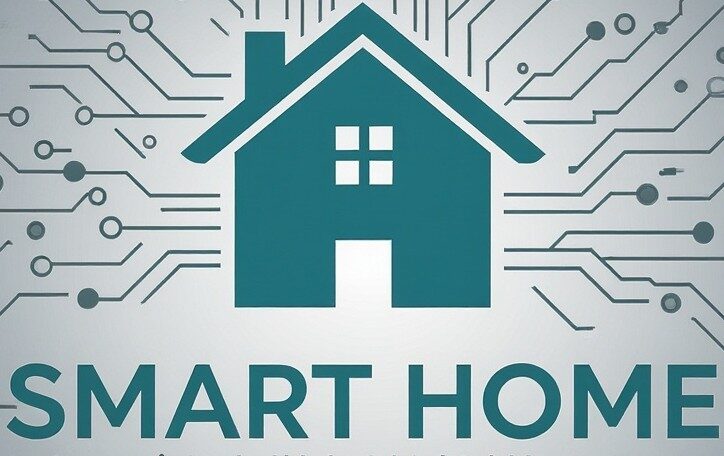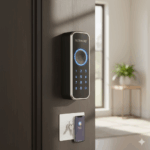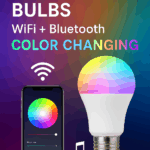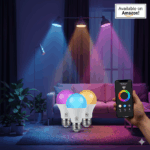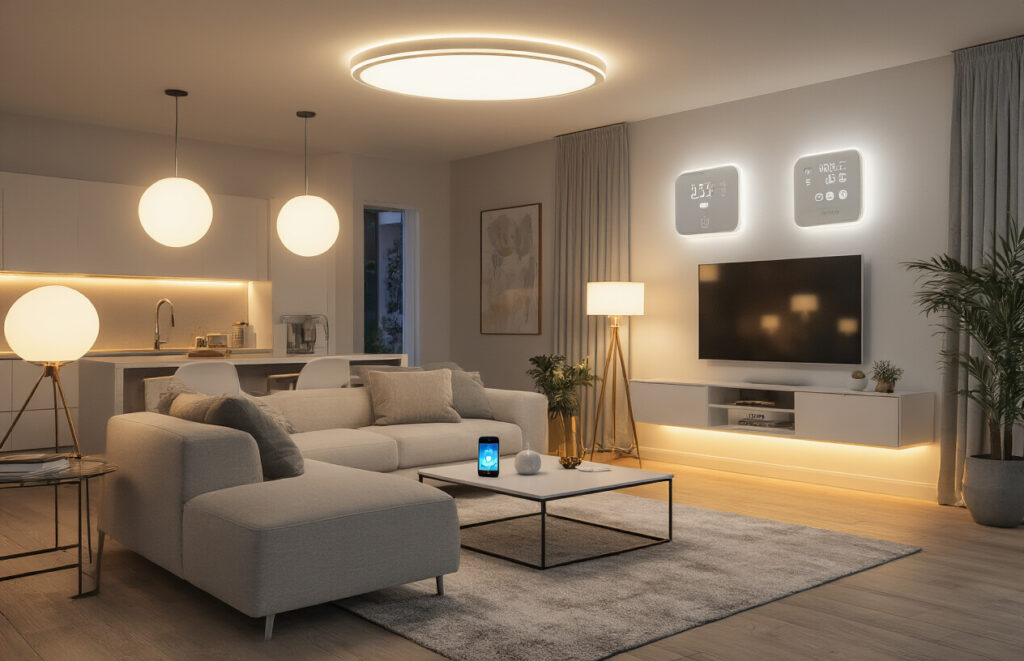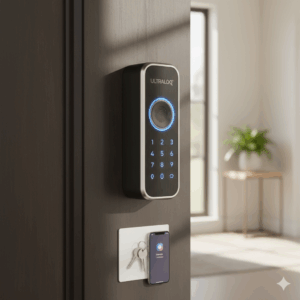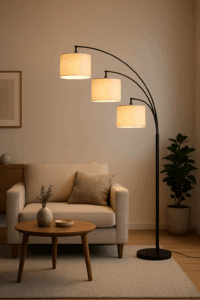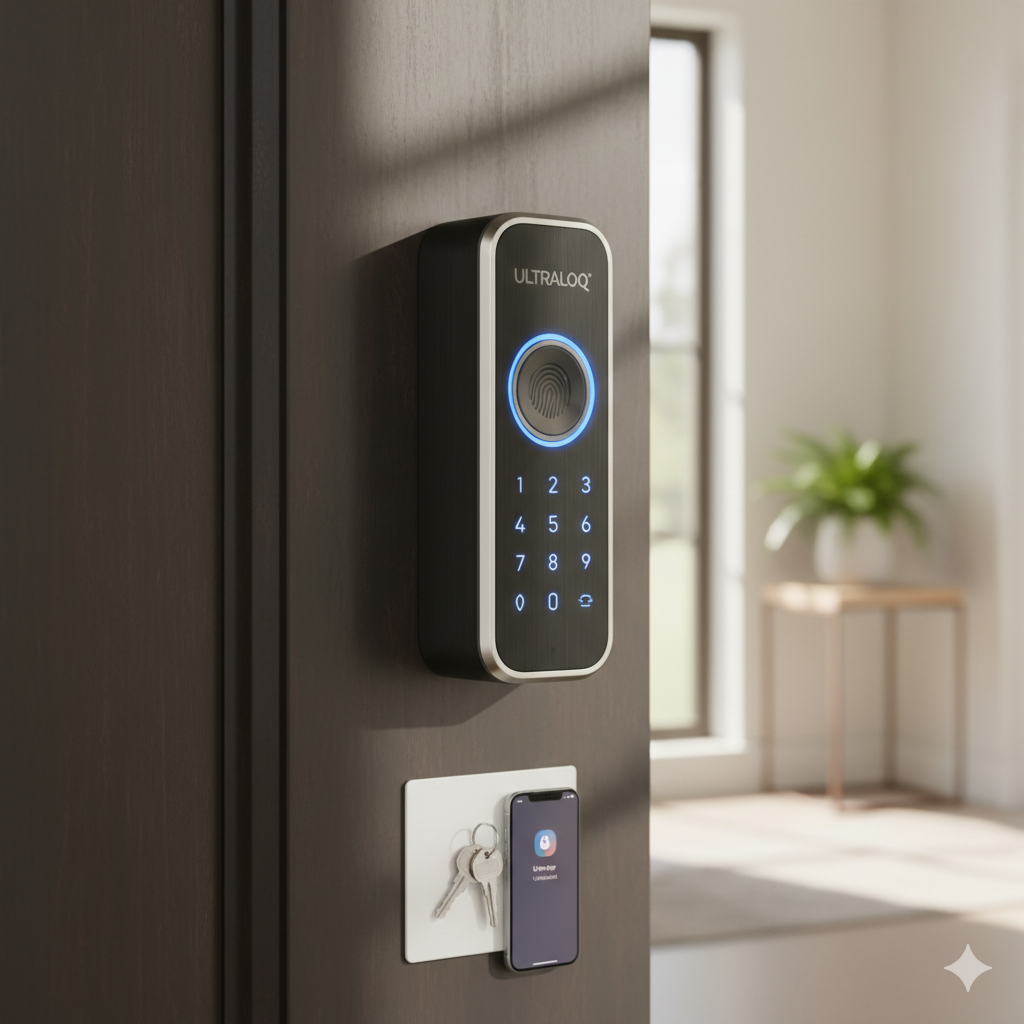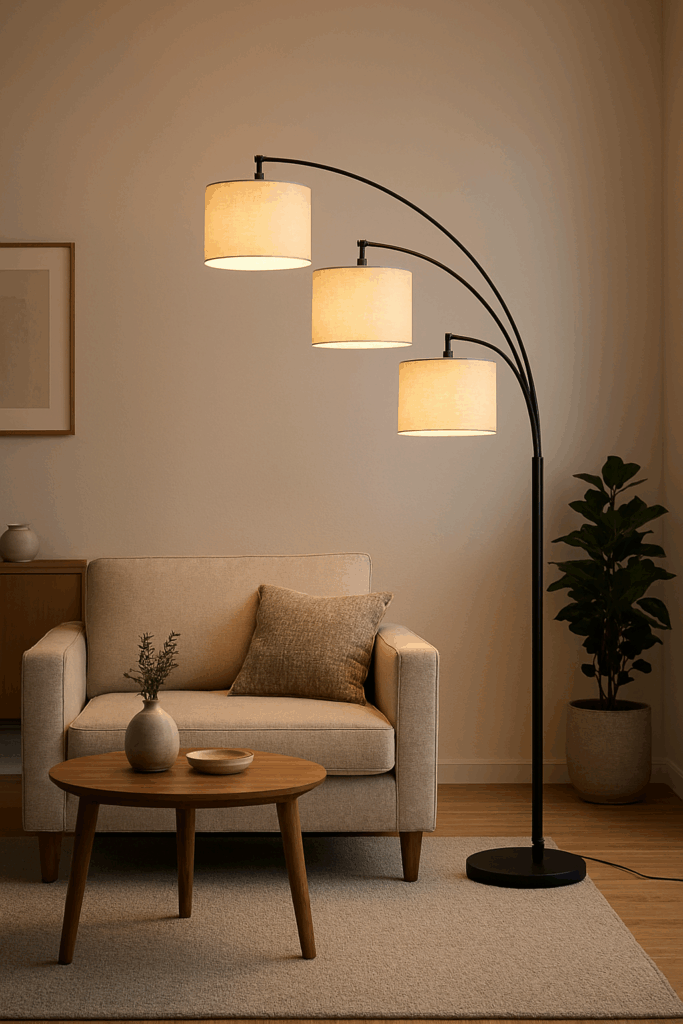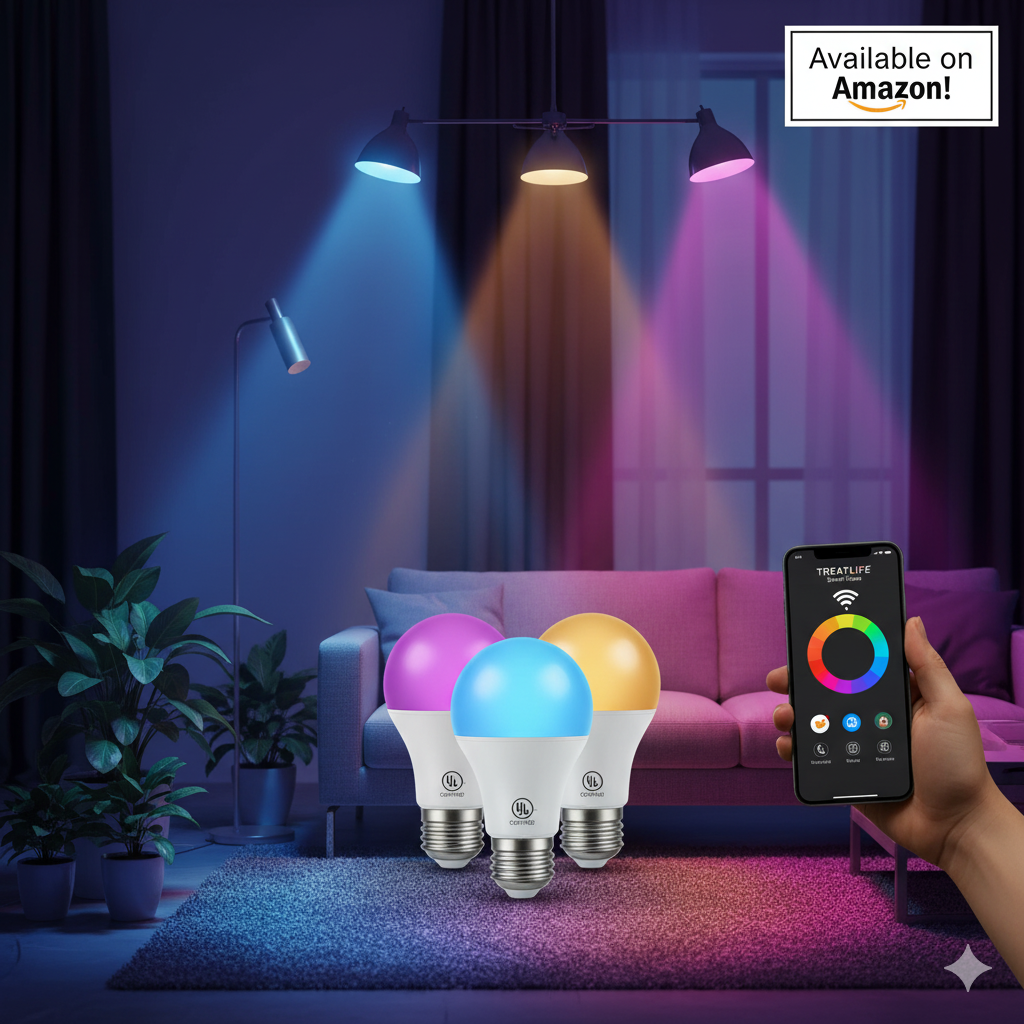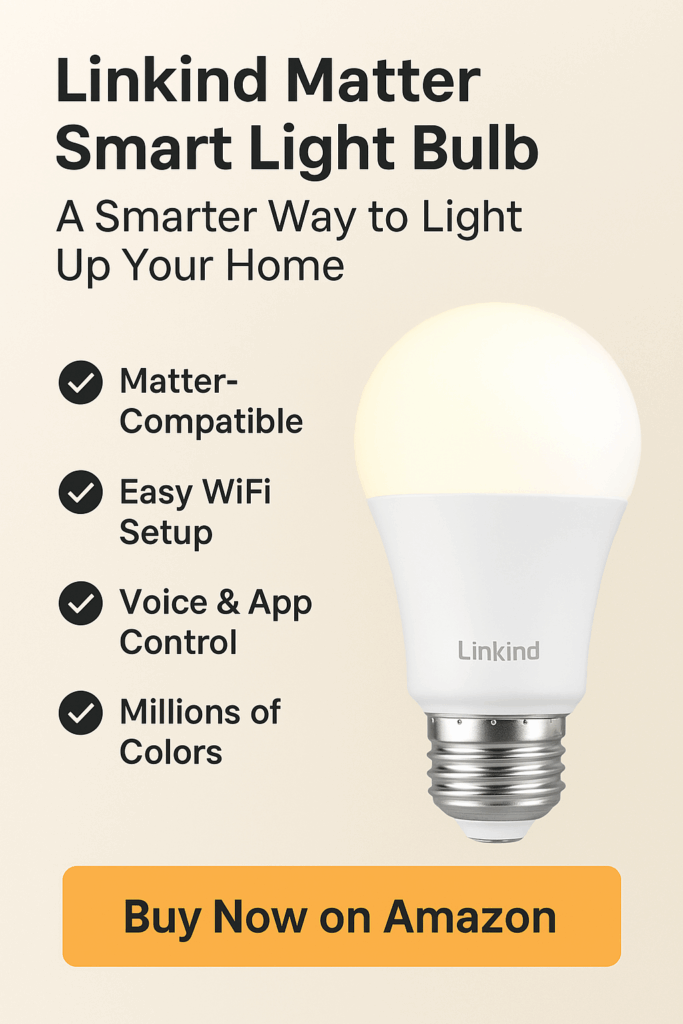
Smart lighting technology transforms ordinary homes into personalized, efficient spaces that respond to your daily routines. This guide is perfect for homeowners ready to upgrade their lighting system and anyone curious about making their living space smarter without breaking the bank.
We’ll explore the essential smart light features that deliver real value for your money, plus walk through the straightforward setup process that gets you enjoying benefits right away. You’ll also discover budget-friendly options that work in any room, with a closer look at the popular Philips Hue A19 LED Smart Light Bulb as a practical starting point.
Transform Your Home with Intelligent Lighting Technology

Experience Hands-Free Control Through Voice Commands
Smart lighting transforms how you interact with your home environment. Simply say “turn on the living room lights” or “dim the bedroom to 30%” and watch as your space responds instantly. Popular voice assistants like Alexa, Google Assistant, and Siri seamlessly integrate with most smart lighting systems, making complex lighting adjustments as easy as having a conversation.
Voice control becomes particularly valuable when your hands are full. Picture carrying groceries into your kitchen or tucking children into bed – no fumbling for switches in the dark. Advanced voice commands allow you to control multiple lights simultaneously, adjust brightness levels, and even change colors without lifting a finger.
Create Perfect Ambiance for Any Occasion
Modern smart lights offer millions of color combinations and precise brightness control to match any mood or activity. Warm amber tones create a cozy atmosphere for movie nights, while bright white light energizes your workspace during productive hours. Many systems include preset scenes like “Dinner Party” or “Reading Time” that instantly adjust multiple lights to predetermined settings.
Color psychology plays a significant role in how lighting affects your daily life. Cool blues and greens promote focus and concentration, perfect for home offices or study areas. Soft purples and warm oranges help you wind down in the evening, naturally preparing your body for restful sleep. Smart scheduling can automatically transition these colors throughout the day, supporting your natural circadian rhythm.
Reduce Energy Bills with Automated Scheduling
Smart lights revolutionize energy efficiency through intelligent automation that adapts to your lifestyle. Occupancy sensors detect when rooms are empty and automatically turn off lights, eliminating energy waste from forgotten switches. Daylight harvesting technology adjusts indoor brightness based on natural sunlight levels, reducing electricity consumption during peak daylight hours.
Scheduling features allow you to program lights to operate only when needed. Set your outdoor security lights to activate at sunset and deactivate at sunrise, or program hallway lights to provide gentle illumination during nighttime hours without disturbing sleep. These automated systems can reduce lighting energy consumption by 30-60% compared to traditional lighting setups.
| Energy Saving Feature | Potential Savings |
|---|---|
| Occupancy Sensors | 20-40% |
| Daylight Harvesting | 15-30% |
| Smart Scheduling | 25-50% |
| LED Technology | 75-80% |
Enhance Home Security with Remote Access
Remote lighting control creates powerful security advantages that protect your property around the clock. Access your lights from anywhere using smartphone apps, allowing you to simulate occupancy while traveling or working late. Random lighting patterns make it appear someone’s always home, deterring potential intruders who typically target predictably empty houses.
Geofencing technology automatically activates lights when you approach your home and turns them off when you leave, creating seamless security transitions. Integration with smart security systems triggers specific lighting responses to detected motion or unusual activity. Emergency lighting modes can instantly illuminate your entire property if security cameras detect suspicious movement, creating a powerful deterrent while providing clear visibility for security monitoring.
Motion-activated pathways guide you safely through your home during nighttime hours while alerting you to unexpected movement when you’re away. These intelligent security features work continuously in the background, providing peace of mind whether you’re home or traveling across the globe.
Essential Smart Light Features That Maximize Your Investment

Customize Colors and Brightness for Optimal Comfort
Your smart lights can transform any room by adapting to your mood, activity, or time of day. Most quality smart bulbs offer millions of color combinations and adjustable brightness levels from 1% to 100%. This flexibility means you can create warm, dim amber lighting for evening relaxation, bright white light for focused work, or vibrant colors for entertaining guests.
The key lies in understanding how different colors affect your well-being. Cool blue and white tones boost alertness and concentration, making them perfect for morning routines or workspaces. Warm oranges and reds promote relaxation and help prepare your body for sleep. Many users create preset scenes like “Movie Night” with soft purple tones or “Dinner Party” with warm golden hues.
Advanced smart lights also support circadian rhythm lighting, automatically shifting from cool daylight tones in the morning to warmer evening colors. This natural progression helps regulate your sleep-wake cycle and can improve overall health.
Set Automated Schedules to Match Your Daily Routine
Smart light scheduling eliminates the hassle of manual adjustments while providing security and convenience benefits. You can program lights to turn on gradually before your alarm, simulating a natural sunrise that makes waking up easier. Similarly, lights can dim automatically as bedtime approaches, signaling your body to wind down.
Weekday and weekend schedules can differ completely. Your lights might follow a strict 6 AM wake-up routine Monday through Friday, then shift to a relaxed 9 AM schedule on weekends. Vacation modes randomly turn lights on and off throughout the day, creating the appearance that someone’s home even when you’re away.
Smart scheduling works especially well when integrated with other smart home devices. Your lights can activate when motion sensors detect movement, turn off when smart thermostats switch to away mode, or brighten when video doorbells detect visitors.
Monitor Energy Usage to Track Savings
Smart lights provide detailed energy consumption data that helps you understand exactly where your electricity dollars go. Most smart lighting apps display real-time usage, daily consumption patterns, and monthly cost breakdowns. This transparency often surprises users who discover which rooms consume the most energy.
LED smart bulbs typically use 75-80% less energy than traditional incandescent bulbs. A 9-watt smart LED produces the same light output as a 60-watt incandescent, translating to significant savings over the bulb’s 15-25 year lifespan. The monitoring features help you optimize these savings by identifying wasteful usage patterns.
Many smart lights can set consumption limits or send alerts when usage exceeds predetermined thresholds. This feature proves valuable for budget-conscious households or rental properties where electricity costs matter. Some utilities even offer rebates for smart lighting installations, making the environmental and financial benefits even more attractive.
Simple Setup Process for Immediate Benefits

Connect Seamlessly to Your Existing Wi-Fi Network
Smart lights work with the Wi-Fi network you already have at home. Most modern smart bulbs connect directly to your 2.4GHz network without needing extra equipment. The connection process takes about two minutes – just screw in the bulb, open the companion app, and follow the simple pairing steps. Your phone will guide you through entering your Wi-Fi password, and the bulb automatically joins your network.
Some premium smart lighting systems use a central hub that plugs into your router. These hubs create a mesh network that keeps your lights responsive even when your internet goes down. The trade-off is one extra step during setup, but the reliability boost makes it worthwhile for larger homes.
Download Apps for Instant Smartphone Control
Every smart light brand offers a free mobile app that becomes your lighting control center. These apps transform your phone into a universal remote for every connected bulb in your house. Download the app from your device’s app store, create a quick account, and you’re ready to start controlling lights from anywhere.
The apps pack impressive features into user-friendly interfaces. Adjust brightness with simple sliders, choose from millions of colors using intuitive color wheels, and set schedules that automatically turn lights on and off. Create lighting scenes for different activities – bright white for reading, warm amber for dinner, or colorful patterns for parties.
Most apps also include location-based automation. Your lights can welcome you home by turning on when your phone detects you’re nearby, or automatically switch off when everyone leaves the house.
Sync with Popular Smart Home Ecosystems
Smart lights play well with voice assistants and home automation platforms you might already own. Amazon Alexa, Google Assistant, and Apple HomeKit all work with major smart lighting brands right out of the box. Link your lights to these platforms through their respective apps, and voice control becomes second nature.
Smart home hubs like Samsung SmartThings, Hubitat, and Home Assistant expand your automation possibilities even further. These platforms let you create complex routines that trigger based on time, motion sensors, or other connected devices. Your lights can flash when the doorbell rings, gradually brighten as your morning alarm goes off, or change colors based on weather conditions.
Replace Traditional Bulbs in Minutes
Installing smart bulbs requires no special tools or electrical knowledge. Turn off the power at the light switch, unscrew your old bulb, and screw in the smart replacement. The process is identical to changing any regular light bulb – if you can change a bulb, you can install a smart one.
Most smart bulbs fit standard lamp sockets and fixtures without modifications. They work in table lamps, ceiling fixtures, pendant lights, and outdoor fixtures. Check the bulb specifications to make sure the size and shape match your fixture before purchasing.
The hardest part is often reaching high fixtures safely. Use a sturdy step ladder and have someone spot you when changing bulbs in ceiling fans or tall fixtures.
Configure Personalized Settings Without Technical Expertise
Smart lighting apps guide you through customization with step-by-step wizards that require no technical background. Setting up schedules feels like using a calendar app – just tap the days and times when you want lights to turn on or off. Creating lighting scenes is as simple as adjusting sliders until you find colors and brightness levels you like, then saving those settings with a custom name.
Advanced features like circadian rhythm lighting adjust automatically throughout the day to support your natural sleep cycle. Morning settings use bright, cool light to help you wake up, while evening modes shift to warm, dim light that prepares your body for sleep. These health-focused features activate with a single toggle switch in the app settings.
The apps remember your preferences across all connected bulbs, so settings you create for one room can instantly apply to others. Group bulbs by room or area to control multiple lights simultaneously with single commands.
Cost-Effective Solutions for Every Budget and Space

Compare LED Smart Bulbs vs Traditional Lighting Expenses
The upfront cost difference between smart LED bulbs and traditional incandescent bulbs might surprise you. A standard incandescent bulb costs around $1-2, while a quality smart LED bulb runs $10-25. That initial sticker shock often stops people from making the switch, but the math tells a different story when you look beyond the purchase price.
Smart LED bulbs consume 75-80% less energy than traditional incandescent bulbs. A 60-watt equivalent smart LED uses only 9-12 watts of actual power. Over the bulb’s 25,000-hour lifespan (compared to 1,000 hours for incandescent), you’ll replace that cheap bulb 25 times while your smart LED keeps running.
| Feature | Traditional Incandescent | Smart LED |
|---|---|---|
| Purchase Price | $1-2 | $10-25 |
| Wattage (60W equivalent) | 60W | 9-12W |
| Lifespan | 1,000 hours | 25,000 hours |
| Replacements needed (25,000 hrs) | 25 bulbs | 1 bulb |
| Total bulb cost | $25-50 | $10-25 |
When you factor in the energy savings, dimming capabilities, and smart features like scheduling and remote control, smart LEDs deliver significantly more value. The ability to dim lights to 1% brightness extends bulb life even further while creating the perfect ambiance for any situation.
Calculate Long-Term Savings on Electricity Bills
Your electricity bill tells the real story of smart lighting savings. Running a 60-watt incandescent bulb for 5 hours daily costs about $13 per year in electricity (at $0.12 per kWh). The same usage with a 10-watt smart LED costs just $2.19 annually – saving you nearly $11 per bulb each year.
Smart bulbs amplify these savings through intelligent features. Motion sensors automatically turn lights off in empty rooms, preventing the “lights left on all day” scenario that drives up bills. Scheduling features dim lights gradually in the evening, reducing energy consumption by 20-30% compared to full brightness operation.
Geofencing takes savings even further by detecting when everyone leaves home and automatically switching off all smart lights. Many families save an additional 15-25% on their lighting costs through this feature alone. The average household with 20 light fixtures can save $150-200 annually just from automated lighting control.
Peak hour electricity rates make smart lighting even more valuable. Programming lights to operate at reduced brightness during expensive peak hours (typically 4-9 PM) can cut your lighting costs by another 10-15%. Some utility companies offer rebates for smart home devices, adding immediate savings to your investment.
Choose Starter Kits for Budget-Conscious Homeowners
Starting your smart lighting journey doesn’t require rewiring your entire house or spending hundreds upfront. Starter kits offer the perfect entry point, typically including 2-4 smart bulbs and a hub for $50-80 – about the same cost as a nice dinner out.
The Philips Hue White Starter Kit gives you two dimmable smart bulbs and the Hue Bridge for around $70. This setup covers your most-used rooms while letting you experience the convenience of app control and voice commands. TP-Link Kasa offers an even more budget-friendly option with Wi-Fi bulbs that don’t need a separate hub, starting at $30 for a 2-pack.
Smart switches present another cost-effective approach for rooms with multiple bulbs. A $20-30 smart switch can control an entire ceiling fixture with four bulbs, giving you smart functionality for less than buying four individual smart bulbs. This works especially well for dining rooms, bedrooms, and bathrooms where you want all lights to operate together.
Begin with high-impact areas like your living room and bedroom – spaces where you spend the most time and use lights frequently. The energy savings and convenience benefits become immediately apparent, building enthusiasm for expanding to other rooms. Many starter kit buyers add 2-3 additional bulbs within the first month as they discover new ways to use smart lighting features.
Philips Hue A19 LED Smart Light Bulb

Premium Performance and Color Options
The Philips Hue A19 LED Smart Light Bulb stands as the gold standard in smart lighting technology, delivering an impressive 16 million colors and 50,000 shades of white light. This flagship bulb produces 800 lumens of brightness while consuming only 9 watts of power, making it roughly equivalent to a traditional 60-watt incandescent bulb but with dramatically lower energy consumption.
What sets this bulb apart from budget alternatives is its exceptional color accuracy and smooth transitions. The color rendering stays vibrant across the entire spectrum, from deep blues and purples to warm reds and oranges. The whites range from cool daylight (6500K) perfect for focused work to warm candlelight (2000K) ideal for relaxation.
Advanced Hub Integration and Ecosystem
The Hue Bridge serves as the central command center, connecting up to 50 bulbs per hub and enabling advanced automation features. This hub-based system creates a mesh network that ensures reliable communication between bulbs and your devices, even in larger homes with multiple floors.
The Philips Hue ecosystem extends far beyond basic lighting control. Integration with voice assistants like Alexa, Google Assistant, and Siri allows for hands-free operation. Smart home platforms including SmartThings, Apple HomeKit, and IFTTT enable complex automation scenarios that sync your lights with security systems, music, and daily routines.
Professional-Grade Customization Features
The Hue app offers scene creation tools that rival professional lighting design software. Users can create custom color palettes, set timers, and establish geofencing triggers that automatically adjust lighting based on your location. The sync feature connects lights to music, movies, and games for immersive entertainment experiences.

Smart lighting technology offers a simple yet powerful way to upgrade your living space without breaking the bank. The features we’ve covered – from voice control and scheduling to energy monitoring and seamless integration – show just how much these intelligent bulbs can do for your daily routine. Setting them up takes minutes, and the immediate benefits you’ll experience make the small investment totally worth it.
Ready to make the switch? Start with a single smart bulb like the Philips Hue A19 LED in your most-used room and see the difference for yourself. You’ll quickly discover how much easier it is to control your lighting, save on energy costs, and create the perfect atmosphere for any occasion. Your home is ready for this upgrade – and your wallet will thank you too.
